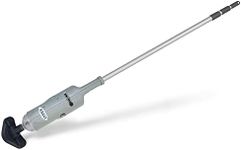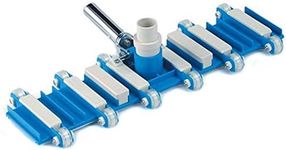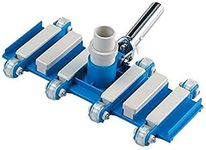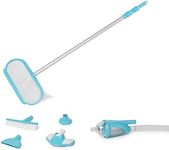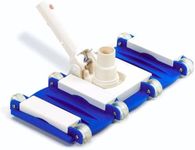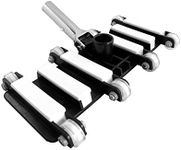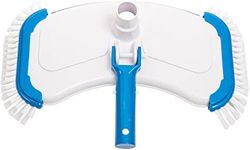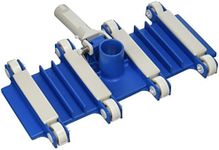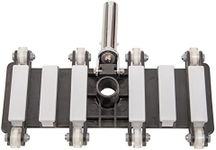Buying Guide for the Best Pool Vacuum Heads
Choosing the right pool vacuum head is essential for keeping your pool clean and making maintenance easier. The right vacuum head will help you efficiently remove dirt, debris, and algae from your pool floor and sometimes even the walls. When shopping for a pool vacuum head, it's important to consider the type of pool you have, the size and shape of your pool, and the kind of debris you typically deal with. Understanding the key specifications will help you select a vacuum head that matches your needs and makes pool cleaning less of a chore.Vacuum Head ShapeThe shape of a pool vacuum head determines how easily it can move around your pool and reach different areas. Common shapes include rectangular, triangular, and butterfly. Rectangular heads are great for large, open areas and provide broad coverage, making them efficient for standard-shaped pools. Triangular heads are better for getting into corners and tight spaces, which is useful if your pool has many angles or steps. Butterfly shapes are designed to glide smoothly and are often used for delicate surfaces. To pick the right shape, consider your pool’s layout—if you have a lot of corners or steps, a triangular head may be best, while a rectangular head is ideal for simple, open pools.
Vacuum Head MaterialThe material of the vacuum head affects its durability and how gentle it is on your pool surface. Most vacuum heads are made from plastic, but some have added weights or metal parts for extra sturdiness. Lightweight plastic heads are easy to handle and suitable for above-ground pools or pools with delicate liners. Heavier, weighted heads are better for in-ground pools because they stay submerged and provide better contact with the pool floor. If your pool has a vinyl liner, choose a head with smooth edges to avoid damage. For concrete or tiled pools, a heavier, more robust head can be more effective.
Brush Type and PlacementThe brushes on a vacuum head help loosen dirt and debris so it can be sucked up more easily. Some heads have bristles all around, while others have them only on the sides or bottom. Soft bristles are gentle on delicate surfaces like vinyl, while stiffer bristles are better for scrubbing tough spots on concrete or tile. If your pool tends to get a lot of algae or stubborn dirt, look for a head with more or stiffer bristles. For regular maintenance or delicate surfaces, softer or fewer bristles are sufficient.
Connection TypeThe connection type refers to how the vacuum head attaches to your pool pole and hose. Most heads are designed to fit standard telescopic poles and hoses, but it’s important to check compatibility. Some heads use clips, while others use locking mechanisms. Make sure the head you choose matches the equipment you already have. If you want a hassle-free setup, look for a head with a universal or easy-to-use connection.
Width of the Vacuum HeadThe width of the vacuum head determines how much area you can clean in one pass. Wider heads (around 14-18 inches) cover more ground quickly, making them ideal for large pools. Narrower heads (8-12 inches) are easier to maneuver and better for small pools or pools with lots of tight spaces. If you have a large, open pool, a wider head will save you time. For smaller or more complex pools, a narrower head gives you better control.
Weighted vs. Non-WeightedWeighted vacuum heads are designed to stay flat on the pool floor, which helps with thorough cleaning, especially in in-ground pools. Non-weighted heads are lighter and may float or tip, which can make cleaning less effective, but they are easier to handle in above-ground pools. If you have an in-ground pool or want a deep clean, a weighted head is usually the better choice. For above-ground or smaller pools, a non-weighted head may be sufficient and easier to use.
